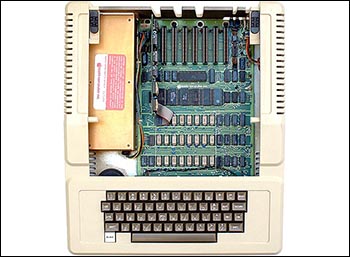Microprocessor Based Digital System: from Bits to Systems

Course introduction
_____________________________________________________________________________________
 Image of Apple II - under the hood |
Microprocessor Based Digital System: from Bits to Systems
GUILLERMO CARPINTERO DEL BARRIO |
Total expected learning time: 24 hours (ECTS)
Course Plan:
14 Lectures
5 Laboratory Exercises
5 Design Problem
PRERREQUISITES AND RECOMMENDED PREVIOUS KNOWLEDGE
We assume knowledge of Digital Electronics (Combinatorial and Sequential), as well as some basic knowledge on electronic circuit design and assembly on protoboards.GENERAL DESCRIPTION OF THE COURSE
This course is oriented to gain skills that enable to design a microcontroller based digital system, from its initial design to putting it to work. The course also aims to give an overview of the impact of these systems in our society, and their influence in our actual lifestyle, shaping our lives.
As new systems can still be developed, the course aims to engage students into the development of their own, inspired in examples shown as design problems of the past. At the present moment, the course is developed on a market available component, the PIC18, on which home brew systems are easily started.
The lectures will introduce the ground knowledge on which the student is expected to grow his own designs. Lectures are intended to introduce the appropriate tools for each step of the development stage.
OBJECTIVES: KNOWLEDGE AND SKILLS
Develop the skills to develop a fully functional embedded system using a microcontroller, being able to specify the system schematic (Hardware) as well as the program (Software).
TEACHING MATERIAL
The published material includes:
1. Lecture material, containing the basic concepts of the course.
2. Laboratory exercises, to allow the students to self-construct their own microcontroller system on a protoboard.
3. Self-Study Quizes. To check the comprehension level of the basic concepts on the lectures.
PRACTICAL ASSIGMENTS AND ASSESSMENT ACTIVITIES
The course grade is obtained from the scores reached from three blocks:
1. Laboratory Grades (25%).
2. Quizes (25%).
3. Exam (50%).